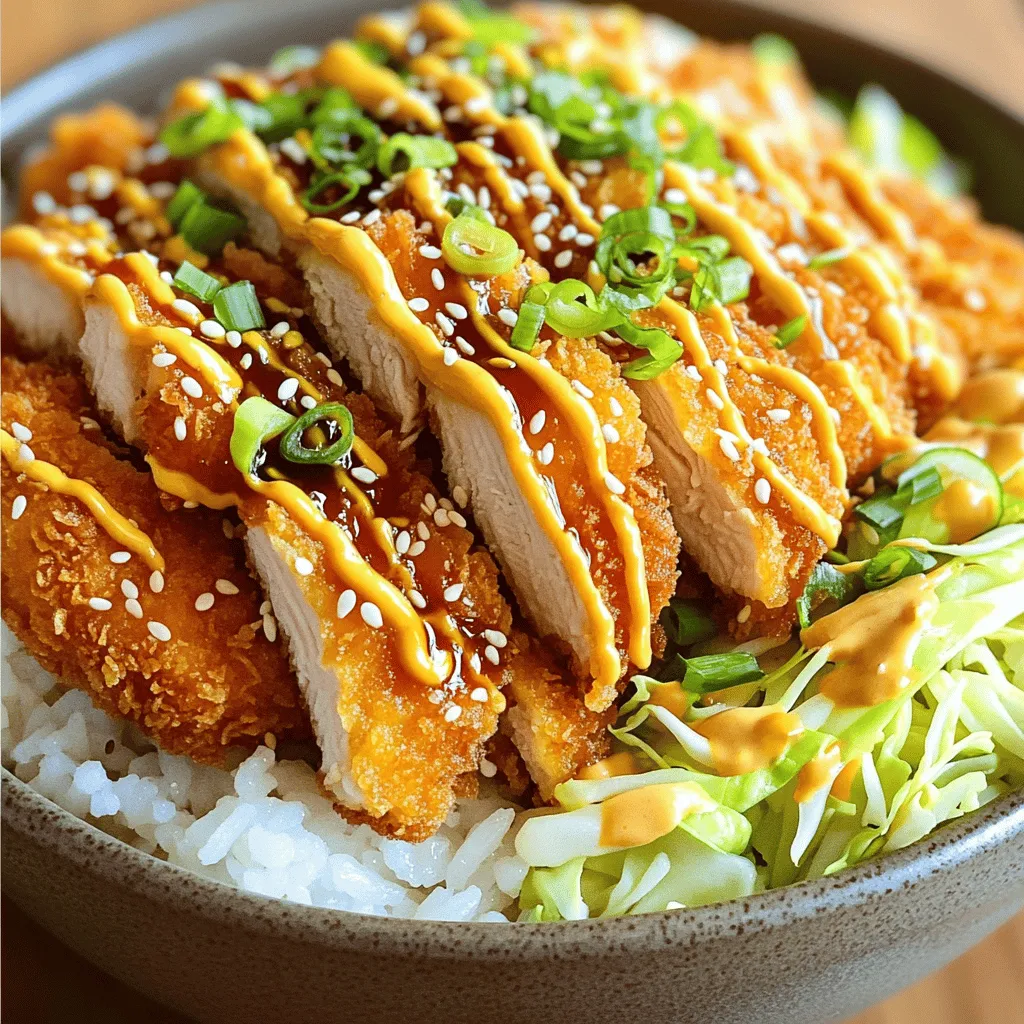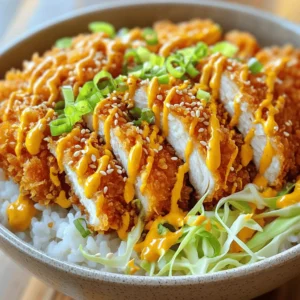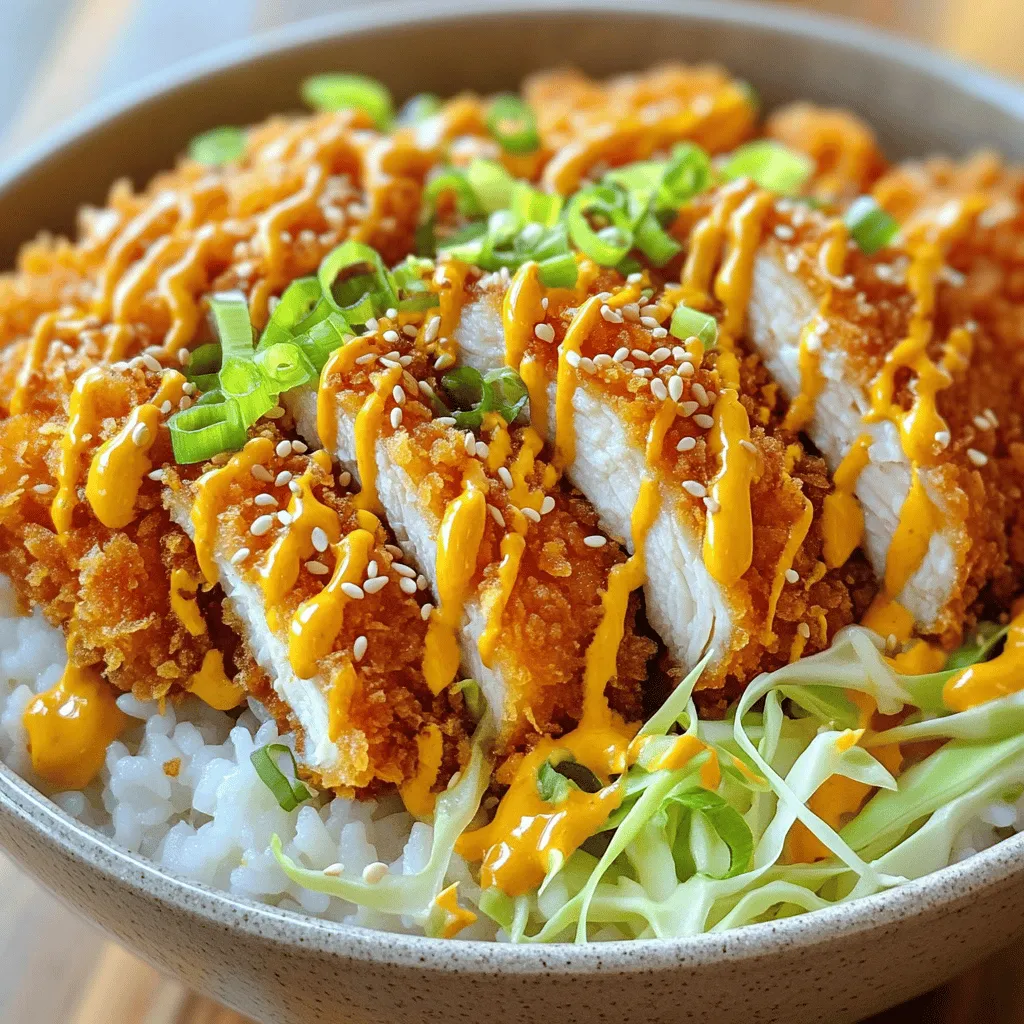Are you ready to dive into the delicious world of Japanese Katsu Bowls? This quick and easy recipe will have you savoring crispy, golden chicken or plant-based options all in one bowl. In this post, you’ll learn about fresh ingredients, simple steps, and pro tips to create the perfect meal. Let’s make your kitchen the place for tasty Japanese comfort food today!
Ingredients
Main Ingredients for Katsu Bowls
– Boneless chicken breasts: The star of this dish. Chicken breasts are lean and cook quickly.
– Panko breadcrumbs: These Japanese breadcrumbs create a light, crispy coating. They are key for that crunch!
– All-purpose flour: This helps the chicken stick to the breadcrumbs. It adds a nice texture.
– Large eggs: Eggs bind the flour and breadcrumbs, ensuring an even coat.
– Salt and pepper: These enhance the chicken’s flavor. Always season your food!
– Garlic powder and onion powder: They add depth to the flavor. Simple but effective!
– Vegetable oil: You need this for frying. It gives the katsu its golden color.
– Jasmine rice: The perfect base for your katsu bowl. It’s fragrant and fluffy.
– Shredded cabbage or lettuce: This adds crunch and freshness. A great contrast to the fried chicken.
– Green onions: These add a nice pop of color and a mild onion flavor.
– Tonkatsu sauce: A sweet and savory sauce that brings everything together. It’s a must-have!
– Optional: Sesame seeds for garnish. They add a nice touch and extra flavor.
Each ingredient plays its role. Freshness matters. Quality ingredients make a difference in taste and nutrition.
Optional Ingredients
– Protein Variations: You can swap chicken for pork or tofu. Each option offers a unique flavor profile.
– Suggested Toppings: Try pickles for a tangy bite or extra sauces for more flavor. Experiment to find what you love!
Step-by-Step Instructions
Preparation of Chicken Katsu
To make chicken katsu, first, pound the chicken. Place each chicken breast between two sheets of plastic wrap. Use a meat mallet or rolling pin to make them even and thin. Aim for about 1/2 inch thick. This keeps the chicken juicy when you cook it.
Next, prepare your coating stations. You need three shallow dishes. In the first dish, mix flour with salt, black pepper, garlic powder, and onion powder. The second dish holds the beaten eggs. The third dish contains panko breadcrumbs, which give katsu its crunch.
Now, let’s coat the chicken. Take one breast and dip it in the seasoned flour. Make sure to cover it well. Shake off the extra flour, then dip it in the eggs. Let any extra egg drip off. Finally, press it into the panko breadcrumbs. Ensure you cover it evenly for a good crunch.
Cooking Process
Heat your oil for frying in a large skillet. Pour in about 1/2 inch of vegetable oil and warm it over medium-high heat. To check if the oil is ready, drop in a small piece of breadcrumb. If it sizzles, it’s hot enough.
Carefully add the coated chicken breasts into the hot oil. Fry each side for 4-5 minutes. You want them golden brown and cooked through. Once done, place the chicken on a plate lined with paper towels. This removes any extra oil.
Assembly of Katsu Bowls
Now it’s time to build your katsu bowl. Start with a base of cooked jasmine rice in each bowl. Neatly lay the sliced chicken katsu on top of the rice. Next, add a handful of shredded cabbage or lettuce for some crunch and freshness.
Finish your bowl by drizzling tonkatsu sauce over the chicken. Sprinkle sliced green onions and optional sesame seeds for a nice touch. Serving these katsu bowls hot makes them even better. Enjoy this delightful dish right away!
Tips & Tricks
Achieving Perfectly Crispy Katsu
To make your katsu crispy, focus on oil temperature. Heat your oil to about 350°F (175°C). This heat helps the breading turn golden brown. If the oil is too cool, your katsu will soak up oil and become soggy. Fry each piece for 4-5 minutes per side. Look for a nice golden color on the outside.
If you don’t want to deep fry, try an air fryer. Coat the chicken as you would for frying. Then, set your air fryer to 380°F (193°C) and cook for about 10-12 minutes. This method gives you a crispy finish with less oil.
Common Mistakes to Avoid
One big mistake is overcooking the chicken. Always check the internal temperature. It should be 165°F (74°C) for safe eating. If you cook it too long, the chicken can dry out.
Another mistake is soggy or uneven breading. Make sure to shake off excess flour and egg before adding the panko. Press down gently to help the crumbs stick. This step ensures the breading is even and holds up during frying.

Variations
Different Protein Options
You can choose different proteins for your katsu bowls. Chicken and pork are the most popular.
– Chicken Katsu: This version is light and juicy. It has a mild flavor that pairs well with tonkatsu sauce. The chicken cooks quickly and stays tender.
– Pork Katsu: Pork has a richer taste. It can be a bit fatty, which adds flavor. Cook it a little longer to ensure it’s done.
If you’re looking for plant-based options, try these:
– Tofu Katsu: Use firm tofu. Slice it and coat it just like chicken. It absorbs flavors well.
– Seitan Katsu: This wheat-based protein has a meaty texture. It’s great for those who want a more hearty meal.
Regional Variations
Katsu bowls vary by region in Japan. Each area has its own twist.
– Hokkaido Katsu: This region often features a creamy curry sauce on top. The warmth of the curry adds a new layer of flavor.
– Osaka Katsu: Here, they may use a thicker tonkatsu sauce. It’s sweeter and richer, making each bite exciting.
Each region also has unique toppings:
– Pickled vegetables: These add a crunchy, tangy bite that contrasts the crispy katsu.
– Egg: Some places serve a soft boiled egg on top. The yolk makes the dish richer and creamier.
Exploring these variations can make your katsu bowls even more fun! For a complete recipe, check out the Full Recipe!
Storage Info
How to Store Leftovers
To keep your katsu bowls fresh, store them in an airtight container. Place the chicken and rice in separate sections. This way, the chicken stays crispy, and the rice stays soft. You can store them in the fridge for up to three days. After that, the quality may drop.
Reheating Tips
When it’s time to enjoy leftovers, reheating can be tricky. To keep the chicken crispy, use the oven. Preheat the oven to 350°F (175°C). Place the chicken on a baking sheet and heat for about 10-15 minutes. This method helps to keep the crunch.
If you’re in a hurry, the microwave is an option. However, it may make the chicken soggy. To minimize this, place a paper towel under the chicken. This helps absorb extra moisture. Enjoy your katsu bowls warm, just like fresh!
FAQs
What is a katsu bowl?
A katsu bowl is a Japanese dish featuring crispy fried meat, usually chicken or pork. The dish includes a base of rice, topped with sliced katsu and vegetables. Katsu bowls are popular in Japan and around the world. They show the blend of flavors and textures that make Japanese cuisine special. The crispy texture of the katsu contrasts nicely with the fluffy rice and fresh veggies.
How to make katsu sauce at home?
Making katsu sauce is simple. You need a few key ingredients:
– 1/4 cup ketchup
– 2 tablespoons soy sauce
– 1 tablespoon Worcestershire sauce
– 1 tablespoon sugar
– 1 teaspoon mustard
– 1 teaspoon garlic powder
Mix these items in a bowl. Adjust the sweetness or tanginess to your taste. This sauce adds a rich flavor to your katsu bowl. You can also find premade tonkatsu sauce in stores for convenience.
Can I use frozen chicken for katsu?
Yes, you can use frozen chicken for katsu. However, you must thaw it first. The best way to thaw chicken is in the fridge overnight. If you’re in a hurry, you can soak it in cold water for a few hours. Make sure to cook the chicken right after thawing. This ensures it stays fresh and safe to eat.
What can I serve with katsu bowls?
Katsu bowls pair well with various side dishes and drinks. Here are some great options:
– Miso soup
– Pickled vegetables
– Edamame
– Green salad with sesame dressing
– Chilled sake or green tea
These sides complement the rich flavors of the katsu and add variety to your meal. Enjoying different textures and tastes makes your katsu bowl experience even better.
Katsu bowls combine fresh ingredients with tasty cooking methods. We covered key elements like the main ingredients, the importance of quality, and ways to customize your dish. I shared tips for cooking perfect katsu and avoiding common mistakes. Explore variations with different proteins to match your taste. Store leftovers properly and enjoy them later. Whether you’re a beginner or an expert, making katsu bowls at home brings joy and flavor to every meal. Embrace this delicious journey and savor every bite!

